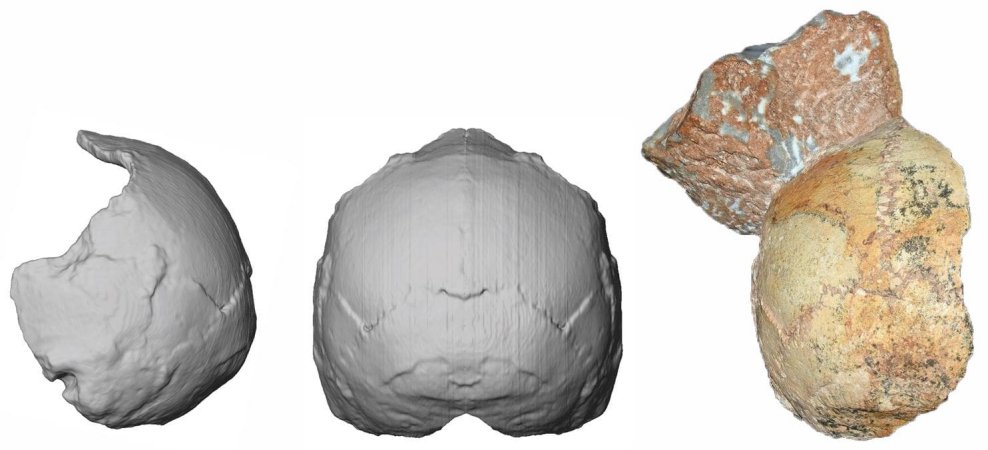Mysterious 210,000-Year-Old Apidima Skull Could Re-Write Human History
Conny Waters - AncientPages.com - When and where did the first human appear? For years, archaeologists and scientists have tried to answer this troublesome question and new discoveries keep forcing us to re-evaluate our understanding of human beginnings.
Now, a mysterious 210,00-year-old skull may have completely re-written human history turning all we know about ourselves more or less upside down.
Credit: Eberhard Karls/University of Tuebingen
In the late 1970s, a peculiar skull was discovered in Apidima cave in southeast Greece. Examination of the ancient skull revealed it belonged to an individual with anatomically modern features.
This skull is extraordinary because it could be the earliest example of Homo sapiens ever discovered outside the African continent. If scientists are not mistaken, then the skull is 160,000 years older than any Homo sapiens fossil previously found in Europe.
There is naturally a lot of disagreement about the conclusion of the studies recently presented in the journal Nature, but researchers involved in the study are suggesting the Apidima Cave fossils provide earliest evidence of Homo sapiens in Eurasia.
Two ancient skulls were found in the Apidima Cave. It was fist thought both belonged to the Neanderthals who lived in Europe before modern humans arrived on the continent.
Later, scientists discovered one of the skulls belonged to a modern human. This means our ancestors migrated out of Africa and reached Europe much earlier than previously thought.
Katerina Harvati, and her team at the University of Tubingen in Germany relied on uranium-thorium dating to estimate the age of the fossil. The results of the study showed the Neanderthal skull was 170,000 years old and the human skull was significantly older: 210,000 years old.
“This age makes it older than any other accepted Homo sapiens specimen outside of Africa,” Harvati said.
“These results suggest that two late Middle Pleistocene human groups were present at this site—an early Homo sapiens population, followed by a Neanderthal population. Our findings support multiple dispersals of early modern humans out of Africa, and highlight the complex demographic processes that characterized Pleistocene human evolution and modern human presence in southeast Europe,” researchers write in the science paper.
According to Mathieu Duval at Griffith University in Nathan, Australia, it uranium-thorium dating method gives the minimum age of the fossils, meaning the skulls could be even older.
As New Scientist reports, “it remains clear that humans evolved in Africa, says Scerri. “The oldest fossils are still in Africa and they’re 100,000 years older than these,” she says.
See also:
10 Surprising Facts About The Neanderthals Who Were Not As Primitive As Previously Thought
However, Scerri says there may have been multiple dispersals out of Africa, perhaps enabled by a greening of the Sahara and Arabian deserts, which happens every 100,000 years.
Scerri and her colleagues promote African multiregionalism: the idea that there were many ancient human populations living in Africa, which were sometimes isolated and sometimes connected. It now seems this web of populations extended beyond Africa.”
“We have this sort of human patchwork of very small populations,” she says.
“An extraordinary claim like this comes with inherent challenges. It's essentially a single data point: one partial skull, damaged and distorted, with a "lack of archaeological context," in the words of the new paper.
The Apidima 1 partial cranium, right, and its reconstruction from side view, left, and posterior view. The rounded shape of the cranium differs from Neanderthals and their ancestors. (Katerina Harvati/Eberhard Karls University of Tübingen/Nature)
There's nothing else: No stone tools, no burial signs, nothing to suggest modern human behavior. The claim would obviously benefit from a second Homo sapiens fossil of similar age somewhere in that part of the world,” The Washington Post writes.
"Of course it would be lovely to find more," said lead author Katerina Harvati of Eberhard Karls University of Tubingen, in Germany, in a conference call with reporters. "We intend to try to look."
The controversial Apidima skull will most likely be debated for a long time and more research is required to determine if it really is the earliest example of Homo sapiens ever discovered outside the African continent, but it’s without doubt a remarkable discovery that offers new insight into our ancient history.
Written by Conny Waters – AncientPages.com Staff Writer






















